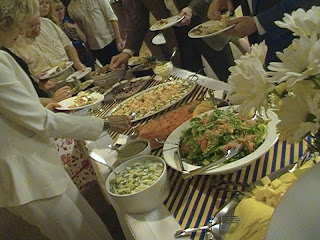Smörgåsbord: A Brief History
Minnesota was once host to several smörgåsbord restaurants before 1970s trends changed the supper club and dining scene. Remember the Jolly Troll? I don't remember the food or the buffet, but I do recall pressing my nose up against the glass to watch the animated trolls that served as the décor.
Smörgåsbord is one of very few Swedish words that, so valuable to American culture, have become part of the English vernacular. It is a special occasion, whether served at home or, currently more common, in restaurants. Literally, it means sandwich table (or bread and butter table) and it is a feast that contrasts husmanskost’s (practical, everyday cuisine) humble simplicity.
Historical accounts of smörgåsbord’s origins demonstrate the progression of abundant feast from simple although not lowly roots. Smörgåsbord is a descendant of the brännvinsbord (literally the burning wine table or spirits table). A practice of the wealthy before elaborate banquets, the brännvinsbord was an appetizer course consisting of bread and butter served with beer. Aquavit became significant to the Swedish palate in the 1700’s and was served with bread, butter, salted and cured fish, meat, and cheese. Similarities to the Russian practice of zakuski (cured and pickled hors d'oeuvres served buffet-style with vodka) is notable, and which custom came first is not established. That practice continues to be evident in the first or herring course of smörgåsbord referred to as SOS (smör, ost och sill – butter, cheese and herring).
During the 16th and 17th Centuries it became common to present all food to be served during the meal on the table upon eating commencement (not unlike what we refer to as service family style). The modern smörgåsbord spread from these customs during the 1880s when travel by train increased as did the need for lodging and public dining. Moreover, new methods in food preservation allowed an abundant feast where out-of-season delicacies appeared alongside seasonal specialties. The popularity of smörgåsbord grew until WWII when due to food shortages the government prohibited it. Reinstituted in 1949, several decades passed before the smörgåsbord was again a national activity.
When my sisters and I were kids our family rarely ate out. Those exceptional dining occasions usually meant that Grandpa was treating, and he loved a good smörgåsbord. Today there are not many places in Minnesota where hungry diners can enjoy a traditional Scandinavian spread. ASI has monthly smörgåsbords, and I've heard rumors of holiday buffets up in the Lindstrom area but have as yet found no evidence. If you know of any, please tell me about them!



Comments